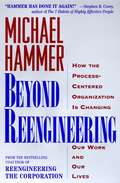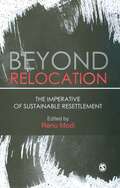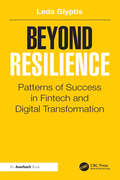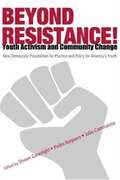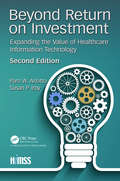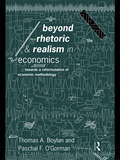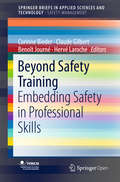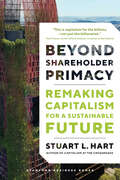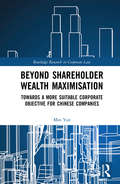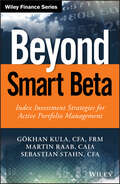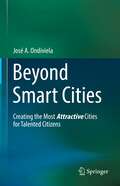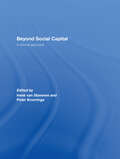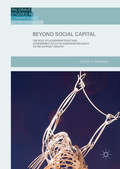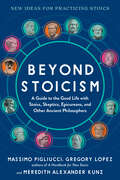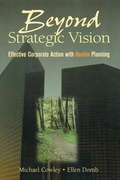- Table View
- List View
Beyond Reductionism: Gateways for Learning and Change
by Neil Douglas Terry WykowskiBeyond Reductionism: Gateways for Learning and Change takes a critical look at organizational learning and change management from a leadership perspective in late 20th century organizations. The authors argue that the dynamics that restrain the efforts of leaders transcend personal attributes and leadership styles. They are rooted in the nature of work and institutions and the histories and cultures of the organizations themselves. Often seen as the central constraint - and the core limiting factor in organizational effectiveness and learning - reductionism is defined as over-simplification and a failure to comprehend the nature of life in organizations by concentrating too fully on discrete and disconnected aspects of reality. The other constraints of hierarchy and institutional knowledge are activated and driven by reductionism.After reading Beyond Reductionism: Gateways for Learning and Change leaders at all organizational levels will understand why low levels of organizational learning persists and change efforts fail. They will also be equipped to recognize and reject overly simplistic and superficial interventions, helping them to create non-reductionist strategies for creating and sustaining change. Actual project designs, experiences, techniques and results are described in the book within an overall framework that emphasizes the roles and interconnectedness of individuals, leaders, and groups, all operating within the overlay of culture.
Beyond Reengineering
by Michael HammerReengineering has captured the imagination of managers and shareholders alike, sending corporations on journeys of radical business redesign that have already begun to transfigure global industry. Yet aside from earning them improvements in their business performance, the shift into more-process-centered organizations is causing fundamental changes in the corporate world, changes that business leaders are only now beginning to understand. What will the revolutions final legacy be? Beyond Reengineering addresses this question, exploring reengineering's effects on such areas as: Jobs: What does process-centering do to the nature of jobs? What does a process-centered workplace feel like? Managers: What is the new role of the manager in a process-centered company? Education: What skills are vital in the process-centered working world, and how can young or inexperienced workers prepare? Society: What are the implications of process-centering for employment and the economy as a whole? Investment: What are the characteristics of a successful 21st-century corporation? An informed look at one of the most profound changes to ever sweep the corporate world, Beyond Reengineering is the business manual for the 21st century.
Beyond Reforms: Structural Dynamics and Macroeconomic Vulnerability
by The World BankBeyond Reform argues that economic growth in developing countries is intrinsically tied to the dynamics of production structures, to the specific policies and institutions created to support it, and the creation of linkages among domestic firms and sectors. Avoiding macroeconomic instability is also essential, however, macroeconomic stability is not a sufficient condition for growth. The broader institutional context and the adequate provision of education and infrastructure are essential "framework conditions", but generally do not play a direct role in bringing about changes in the momentum of economic growth.
Beyond Relocation: The Imperative of Sustainable Resettlement
by Renu ModiThis collection addresses critical issues of development-induced displacement and resettlement by offering empirical evidence from various countries, mainly in Asia and Africa. By presenting a comparative approach, it helps the reader understand and theorise about the nature and characteristics of forced displacement in several countries across the globe. It also studies the interaction among an array of actors; in particular, policy-makers, development agencies, project-affected persons, researchers and NGOs in resistance movements. Most significantly, the study offers measures to reverse and reconstruct impoverishment caused by displacement in a holistic way through benefit-sharing mechanisms which can lead to sustainable resettlement and rehabilitation. Beyond Relocation: the Imperative of Sustainable Resettlement emphasizes the need for reforming laws and policies dealing with displacement and resettlement in the Indian as well as the global context. It analyses thee issues of risks, impoverishment, entitlements and survival strategies of those displaced. This volume will be of immense value to project planners, funders and implementing agencies in view of the fact that development planners are faced with a daunting task in the process of constructing/improving the existing network of roads, railways and airport facilities which run through existent human settlements and require the acquisition of large tracts of land, leading to involuntary displacement. The essays will also be helpful for researchers engaged in the field of development and displacement studies.
Beyond Resilience: Patterns of Success in Fintech and Digital Transformation
by Leda GlyptisIs success pattern-based? Is the journey of successfully building new banks or services (either from scratch or in the context of a going concern) predictable enough to be repeatable? And if there are patterns, are they within our gift to replicate?Beyond Resilience: Patterns of Success in Fintech and Digital Transformation asks these questions and seeks answers among the people who have first-hand experience of building new things and who live to tell the tale.This book is not a hagiographic founder story that elevates the founder’s own narrative to a montage of challenge and resilience, grit, perseverance and a soaring successful crowning at the end: a narrative that, figuratively speaking, can play out while ‘Eye of the Tiger’ is blaring in the background. Nor is the book a series of vendor testimonials that cover in a few thousand words each their own triumphant digital projects. These stories are not untrue but can be too generic to be illuminating, too vague to be helpful and too hollow to be the whole truth.Filled with interviews from leading fintech entrepreneurs, this book strives to tell the whole truth about building new things. It shares the stories of leaders who admit that as they built their businesses, they learned a lot, changed a lot, and made mistakes and had to course-correct. The book attests that leading new fintech ventures or digital transformations, whether they are started with a blank sheet of paper or within an established entity, is hard and unpredictable. It requires control. It requires consistency and integrity. It requires standing strong either alone or with a team. It requires going beyond resilience.
Beyond Resilient: The Coach's Guide to Ecstatic Growth
by Marc CordonThe key to optimal living is not only bouncing back from failures but looking forward to the opportunities for extraordinary growth that they provide. Life coaches serve their clients from languishing to flourishing, but they are not impervious to life’s stress, vulnerabilities, and dissonance. In Beyond Resilient, life coach Marc Cordon weaves philosophy, positive psychology theory, and pop cultural references together to show how coaches and clients alike can use their daily experiences to unlock extraordinary outcomes in mental wellbeing, life transition, business performance, and leadership. Coaches and clients learn how to alleviate the internal mental chatter that causes self-doubt, while using resistance, criticism, and even failure to fuel their growth.
Beyond Resistance! Youth Activism and Community Change
by Shawn Ginwright Julio Cammarota Pedro NogueraOver the past decade, urban communities have experienced unprecedented social, economic, and political transformation. Globalization and de-industrialization have contributed to the exodus of jobs, produced higher levels of inequality, and consequent, furthered marginalization of the urban poor. Urban youth have been particularly affected by this transformation. The failure of urban school districts and the lack of jobs, health services and effective prevention and intervention programs have placed large numbers of low-income urban youth at risk. In the absence of policies and institutions that respond to the needs of youth, a climate of fear focused particularly on responding to fears of youth crime has also shaped a national consciousness about urban communities and the youth within them. Urban Youth and CommunityChangebrings together work by leading scholars who study urban youth and who have a grounded knowledge of the issues they face. A commitment to social justice and equity is aunifying theme for this volume, and each of the authors examines to varying degrees how such values and commitments can be incorporated into public policy. The goal of this edited volume is to draw on the knowledge and expertise of these scholars from various academic disciplines and to share with policymakers and the general public insights into the impact of punitive/zero tolerance policies on young people's educational experience and well being. These chapters also offer new ideas about how to support youth placed at risk by deteriorating circumstances in urban areas and offers recommendations on how to create more humane and responsive youth policies at the local, state and federal level.
Beyond Return on Investment: Expanding the Value of Healthcare Information Technology, 2nd Edition (HIMSS Book Series)
by Pam Arlotto Susan P. IrbyBeyond Return on Investment: Expanding the Value of Healthcare Information Technology, 2nd Edition this updated and revised edition provides lessons learned from healthcare IT adoption and the opportunity to drive value realization. From providing a basic primer on 'how-to' complete a Return on Investment analysis for a single project to developing a comprehensive program of value management to support the transition to high value healthcare, this book addresses emerging trends, practical approaches and measurement methods to help drive value. Beyond Return on Investment, 2nd Edition views IT as a strategic asset in the transformation of healthcare. Based on previous editions, this book updates and identifies the components of an integrated value management strategy including value driven decision-making culture, an integrated approach to strategy development, a value based governance model, a process that defines business case development through ROI analysis, value measurement and value scorecard development. New chapters in this addition include a Framework for Value Management, validating vendor defined value and ROI, and new methods for realizing value.
Beyond Rhetoric and Realism in Economics: Towards a Reformulation of Methodology
by Thomas Boylan Paschal O'GormanBoylan and O'Gorman inject a fresh empiricist voice into the recent debates in economic methodology.... praise the book for its careful scholarship, its intellectual novelty and its familiarity with existing methodological literature." D. Wade Hands, University of Puget Sound, USA
Beyond Right and Wrong: The Power of Effective Decision Making for Attorneys and Clients
by Randall KiserThis book guides attorneys and clients through legal decision making. It analyzes 11,306 attorney-client decisions in actual cases and summarizes decades of research regarding judge, jury, litigant and attorney decision making. To explain why many litigation outcomes are suboptimal, the book describes the psychological and institutional factors that impede sound decision making. The roles of attorneys and clients in legal decision making and the legal malpractice and disciplinary consequences of ineffective legal representation also are discussed. To rapidly promote better financial outcomes in civil litigation and to assist attorneys and clients in becoming expert decision makers, the book presents more than 65 ideas, methods and systems for improving personal and group decision making.
Beyond Safety Training: Embedding Safety in Professional Skills (SpringerBriefs in Applied Sciences and Technology)
by Corinne Bieder Claude Gilbert Benoît Journé Hervé LarocheThis book is open access under a CC BY 4. 0 license. This book investigates why, despite more and more resources devoted to safety training, expectations are not entirely met, particularly in the industrial sectors that have already achieved a high safety level. It not only reflects the most precious viewpoints of experts from different disciplines, different countries, with experiences in various industrial fields at the cutting edge of theories and practices in terms of safety, professionalization and their relationships. It also consolidates the positioning of the Foundation for an Industrial Safety Culture, highlighting what is currently considered at stake in terms of safety training, taking into account the system of constraints the different stakeholders are submitted to. It reports some success stories as well as elements which could explain the observed plateau in terms of outcome. It identifies some levers for evolution for at-risk industry and outlines a possible research agenda to go further with experimental solutions.
Beyond Sarbanes-Oxley Compliance: Effective Enterprise Risk Management
by Anne M. MarchettiDesigned to lead financial managers from initial compliance with the Sarbanes-Oxley Act, through ongoing maintenance and monitoring, Beyond Sarbanes-Oxley Compliance helps readers seize this opportunity to revitalize their business practice, drive greater performance, and transform their finance organization into a key contributor to the business. Focusing on the present and future financial road ahead, Beyond Sarbanes-Oxley Compliance explores how to implement enterprise risk management processes that comply with Sarbanes-Oxley 302/404/409 requirements, ways to build on initial compliance activities that will improve financial management processes and profitability, compliance and quarterly close checklists, timelines, and table summaries to help readers achieve their goals, and much more.
Beyond Scarcity: Water Security in the Middle East and North Africa
by World BankWater has always been a source of risks and opportunities in the Middle East and North Africa. Yet rapidly changing socioeconomic, political, and environmental conditions make water security a different, and more urgent, challenge than ever before. This report shows that achieving water security means much more than coping with water scarcity. It means managing water resources in a sustainable, efficient, and equitable way. It also involves delivering water services reliably and affordably, to reinforce relationships between service providers and water users and contribute to a renewed social contract. Water security also entails mitigating water-related risks such as floods and droughts. Water security is an urgent target, but it is also a target within reach. A host of potential solutions to the region’s water management challenges exist. To make these solutions work, clear incentives are needed to change the way water is managed, conserved, and allocated. To make these solutions work, countries in the region will also need to better engage water users, civil society, and youth. The failure of policies to address water challenges can have severe impacts on people’s well-being and political stability. The strategic question for the region is whether countries will act with foresight and resolve to strengthen water security, or whether they will wait to react to the inevitable disruptions of water crises.
Beyond Shareholder Primacy: Remaking Capitalism for a Sustainable Future
by Stuart HartFrom the author of Capitalism at the Crossroads, a call to consciousness—and action—for individuals, organizations, communities, and nations. Our current Milton Friedman–style "shareholder primacy capitalism," as taught in business schools and embraced around the world, has become dangerous for society, the climate, and the planet. Moreover, Stuart L. Hart argues, it's economically unnecessary. But there are surprising reasons for hope—from the history of capitalism itself. Beyond Shareholder Primacy argues that capitalism has reformed itself twice before and is poised for a third major reformation. Retelling the origin story of capitalism from the fifteenth century to the present, Hart argues that a radically sustainable, just capitalism is possible, and even likely, in our lifetime. Hart goes on to describe what it will take to move beyond capitalism's present worship of "shareholder primacy," including corporate transformations to re-embed purpose and reforms to major economic institutions. A key requirement is eliminating the "externalities" (or collateral damage) of our current shareholder capitalism. Sustainable capitalism will explicitly incorporate the needs of society and the planet, include a financial system that allows leaders to prioritize the planet, reorganize business schools around sustainable management thinking, and enable corporations not just to stop ignoring the damage they cause, but actually begin to create positive impact.
Beyond Shareholder Wealth Maximisation: Towards a More Suitable Corporate Objective for Chinese Companies (Routledge Research in Corporate Law)
by Min YanThe corporate objective, namely, in whose interests a company should be run, is the most important theoretical and practical issue confronting us today, as this core objective animates or should animate every decision a company makes. Despite decades of debate, however, there is no consensus regarding what the corporate objective is or ought to be, but clarity on this issue is necessary in order to explain and guide corporate behaviour, as different objectives could lead to different analyses and solutions to the same corporate governance problem. In addition to the study on the corporate objective in Anglo-American jurisdictions, the discussion of this topic in the context of China is also very important on the grounds that China has become the second largest economy in the world and is playing an increasingly significant role in global affairs. Though a socialist state, China has also been relying heavily on the corporate vehicle as the most important business organisational form to ensure its rapid economic development since its market reforms in 1978. Adolf Berle and Gardiner Means’s observation made over eight decades ago that large public companies dominate the world remains true today, not only in the West but also in China. The regulation and governance of such companies will have a material impact on the further development of the Chinese economy, which could in turn directly affect the world economy. Company law and corporate governance therefore receive much attention and have become a vital issue in China. Although the current focus is primarily on corporate performance, the fundamental question at the heart of corporate governance, namely the corporate objective, is still unresolved. Contrary to the widely held belief that the corporate objective should be maximising shareholder wealth, this book seeks to demonstrate that the shareholder wealth maximisation approach is both descriptively inaccurate and normatively unsuitable. As an antithesis to it, stakeholder theory generally develops to be a more suitable substitute. Justifications and responses to its main criticisms are offered from descriptive, normative and instrumental aspects, whilst new techniques of balancing competing interests and more workable guidance for directors’ behaviour are brought forward as essential modifications. Along with the unique characteristics of socialist states, the stakeholder model is expected to find solid ground in China and guide the future development of corporate governance. This book will be important and useful to researchers and students of corporate law, corporate governance, business and management studies.
Beyond Smart Beta: Index Investment Strategies for Active Portfolio Management
by Gökhan Kula Martin Raab Sebastian StahnDelve into ETFs for smarter investing and a weatherproof portfolio Beyond Smart Beta is the investor's complete guide to index investing, with deep analysis, expert clarification and smart strategies for active portfolio management. From the general to the obscure, this book digs into every aspect of Exchange Traded Funds (ETFs) including ETCs and ETNs to break down the jargon and provide accessible guidance on utilising the indices as part of a more productive investment strategy. Succinct explanations of terms and concepts help you better grasp ETP anatomy, mechanics and practices, while examples, charts and graphs provide quick visual reference for total understanding. The expert author team examines the risks and benefits associated with various indexing approaches, sharing critical review of next-generation methods to help you make well-informed investment decisions. ETFs provide a solid foundation within mature and well-researched markets, allowing investors to focus on areas where active management has the potential to reap higher returns. This book shows you how to take full advantage of the growth of this market to strengthen your portfolio for the long term. Assess the current landscape and the anatomy of ETFs/ETPs Understand ETP handling, costs, trading, and investment Evaluate the pros and cons of next-generation indexing approaches Avoid risk while incorporating indices into an active portfolio management strategy Index concepts have evolved from basic, passive investments through Smart Beta, and are evolving into a third generation of products that will quickly become an important element of investor portfolios. Key benefits have propelled ETFs to surpass hedge funds in global capital, and the growth shows no sign of slowing. Beyond Smart Beta provides a primer for investors seeking to understand — and take advantage of — these lucrative new products.
Beyond Smart Cities: Creating the Most Attractive Cities for Talented Citizens
by José A. OndivielaCities are experiencing unprecedented times. In addition of managing the best possible post-pandemic recovery, Cities are at the beginning of the 4th industrial revolution, and all want to play a relevant role in it. To achieve this, they must retain and attract the necessary talent. There is a fierce competition where cities transform to become as attractive as possible. But what makes a city attractive (from emotional and rational sides) to talented citizens? For mayors and city directors: how can I prepare my city for this goal? What kind of transformations in the medium-long term should I develop? And in the short term, what processes and technologies (SmartCity) should I put in place? And from the point of view of citizens: how do I choose the best city to develop my full potential? Which one offers me the best citizenship contract? Where am I going to enjoy the best services with the highest quality of life and lower taxes/cost of life? In addition, the city must be attractive, with a strong identity and dynamism and promising future. Can I find the cities that best suit my aesthetic and emotional preferences, and that also offer me the services that I consider a priority at the lowest cost to my pocket? Find all the answers in this book.
Beyond Social Capital: A critical approach
by Irene van Staveren and Peter KnorringaChina is poised to gain global importance as a growth engine for the world economy on a par with Europe and the USA. Japanese multinational enterprises are increasingly active in relocating to China their R&D and capital- and knowledge-intensive production for both export-platform and target market reasons. It is at the juncture of the growing
Beyond Social Capital: The Role of Leadership, Trust and Government Policy in Northern Ireland's Victim Support Groups (Palgrave Studies in Compromise after Conflict)
by Laura K. GrahamDrawing on lessons from civil society in Northern Ireland, Beyond Social Capital examines the limitations of social capital theory in deeply divided societies. It draws on an ethnographic study of victim support groups and evidence drawn from policymakers in Northern Ireland to reconceptualize the traditional bonding-bridging distinction. The role of leadership is particularly examined, as the book highlights the complex and compelling ways in which leadership supports and shapes the activities, practices and motivations of the victim self-help industry in Northern Ireland. The multiple dimensions of this industry are explored, including: social and victim policy; private, statutory, and voluntary sector collaboration; the political motivations of victim support groups, and; the types of social capital being built in victim groups and the impact that this social capital has on victims and wider elements of the peace process. Importantly, Laura K. Graham challenges the prevailing notion that all forms of social capital are inherently good for civic organizations and associational life. Instead, a new form of social capital existing in divided and post-conflict societies is advanced. This form of social capital, called 'dysfunctional bonding', may have negative impacts, causing distrust within and outside a group and can be particularly problematic for those traumatized by political conflict. With international relevance, this book will be of great interest to those working in post-conflict studies as well as victim studies.
Beyond States and Markets: The Challenges of Social Reproduction (RIPE Series in Global Political Economy)
by Isabella Bakker Rachel SilveySeeking to extend our understanding of the contemporary global political economy, this book provides an important and original introduction to the current theoretical debates about social reproduction and argues for the necessity of linking social reproduction to specific contexts of power and production. It illustrates the analytic value of the concept of social reproduction through a series of case studies that examine the implications of how labor power is reproduced and how lives outside of work are lived. The issues examined in countries including the Ukraine, Chile, Spain, Nepal, India and Indonesia, consist of: Human trafficking and sex work Women and work Migration, labor and gender inequality Micro-credit programs and investing in women Health, biological reproduction and assisted reproductive technologies The book lends a unique perspective to the understandings of transformation in the global political economy precisely because of its simultaneous focus on the caring and provisioning of the everyday and its relationships to policies and decisions made at the national and international levels of both formal and informal institutions. With its multi-disciplinary approach, this book will be indispensable to students and scholars of International Political Economy, Development Studies, Gender or Women’s Studies, International Studies, Globalization and International Relations.
Beyond Stoicism: A Guide to the Good Life with Stoics, Skeptics, Epicureans, and Other Ancient Philosophers
by Massimo Pigliucci Gregory Lopez Meredith Alexander KunzNavigate the challenges of modern life, with ancient and time-tested Greek and Roman thinkers at your side. What is a good life? And how can we create that life in a world filled with uncertainty? Beyond Stoicism invites you to find your own answers to these big questions with help from thirteen of the most prominent Greco-Roman philosophers—many of whom inspired, or were inspired by, the Stoics. By taking cues from the lives and ideas of the Cynics, Epicureans, and others, you’ll learn to: Seek pleasure with Aristippus Strike the right balance with Aristotle Focus on what’s up to you with Epictetus Be a rebel like Hipparchia Embrace uncertainty with Carneades Question everything with Socrates Work toward a just society with Plato And much more Times have changed, but the quest for eudaimonia—a life worth living—stays the same: We still seek pleasure and crave love, avoid pain and fear death. That’s why all these ancient sages can continue to guide us, practicing Stoics and new seekers alike. With exercises to help you test-drive each philosophy today
Beyond Storytelling: Narrative Ansätze und die Arbeit mit Geschichten in Organisationen
by Jacques ChlopczykBeyond Storytelling stellt unterschiedliche Ans#65533;tze, Methoden, Werkzeuge und konkrete Beispiele f#65533;r die Arbeit mit Geschichten in Organisationen vor. Dabei hat das Buch zum Ziel, sowohl grundlegende Aspekte und Konzepte narrativer Ans#65533;tze in Organisationen zu beleuchten, als auch anhand von konkreten Praxisbeispielen das Potential dieser Ans#65533;tze f#65533;r Marketing, Kommunikation, Organisationsentwicklung, Coaching, Wissensmanagement und Lernen in Organisationen aufzuzeigen. Dieses Buch ist eine Einladung dazu, die Arbeit mit Geschichten weiter zu fassen als das Erz#65533;hlen attraktiver ,,Stories". Im Buch wird in den verschiedenen Beitr#65533;gen ein transdisziplin#65533;rer Ansatz entwickelt, der Geschichten als grundlegendes Prinzip menschlichen Denkens, F#65533;hlens und Handeln begreift. Die vorgestellten narrativen Methoden und Ans#65533;tze erm#65533;glichen es f#65533;r Organisationen neue Denk- und Handlungsr#65533;ume zu erschlie#65533;en. Das Buch ist dabei nicht als Endpunkt einer Geschichte gedacht, sondern als Auftakt fur eine intensive Auseinandersetzung mit dem Potential dieses Ansatzes f#65533;r Organisationen und Unternehmen.
Beyond Strategic Kaizen: Performing Synchronous Profitable Operations
by Alin PosteucăCurrently, the challenge for manufacturing organizations is how to achieve their expected profit by continuously improving productivity or reducing costs. Manufacturing organizations have been using different improvement approaches to achieving cost reduction and productivity improvement for years by eliminating various losses and waste structures, such as excess inventory, excessive workforce, excessive capacity, excessive utility consumption, and so on. But is the problem solved? Unfortunately, no! Often manufacturing companies focus on maximizing the flow and meeting customer needs but forget their real aim – to make a profit for their stakeholders. Too many organizations meet customer expectations by seeking to continuously synchronize the flow to market demand but forget to check that they are doing it profitably enough to ensure business continuity and prosperity. When the financial results show that they are not so profitable, it is already too late. Moreover, the strategic direction of systematic improvements according to the sales trend – depending on the current degree of production capacity utilization and its dynamic effects on cost structures – is deficient in many manufacturing companies. So, would the failure of strategic and profitable systematic improvements be an option? Of course not! If the ultimate goal of the organization is to create target profit for stakeholders, then the behavior and strategic systematic improvements must be directed to those scenarios, strategies, tasks, problems, and “production levers” that are best based on creating the target profit. That’s what Strategic Kaizen thinking does – the simultaneous and consistent achievement of systematic operational and financial improvements in a strategic and operational manner. It achieves both synchronous operations at market demand by fulfilling takt time and profitable operations in accordance with profit demand by fulfilling takt profit. In short, the Strategic Kaizen mission is striving for the fulfillment of the ideal state of operations called synchronous profitable operations. In this book, the author, while presenting in detail the seven processes of Strategic Kaizen methodology, exposes the answer to historically incomplete thinking of productivity improvements for target profitability. The uniqueness of the book is reinforced by the detailed presentation of the successful application of the Strategic Kaizen thinking over the years in two multinational manufacturing organizations operating in highly competitive markets, addressing the synchronous profitable operations for both the sales increase scenario and the sales decrease scenario. Moreover, it presents examples of the practical application of the “white-collar” Strategic Kaizen. Essentially, by adopting the Strategic Kaizen methodology presented in detail in this book to consistently achieve the ideal state of a manufacturing organization, organizations will enter a new paradigm of thinking of strategic improvements – Strategic Kaizen thinking – to meet annual and multiannual target profits in a unique and effective way that operates according to its own strategic and operational management system.
Beyond Strategic Vision: Effective Corporate Action With Hoshin Planning
by Michael Cowley Ellen DombHoshin is a system which was developed in Japan in the 1960's, and is a derivative of Management By Objectives (MBO). It is a Management System for determining the appropriate course of action for an organization, and effectively accomplishing the relevant actions and results. Having recognized the power of this system, Beyond Strategic Vision tailors the Hoshin system to fit the culture of North American and European organizations. It is a "how-to" guide to the Hoshin method for executives, managers, and any other professionals who must plan as part of their normal job. The management of an organization, whether it be large or small, has as one of its principal responsibilities setting the direction of the organization for the future. The most effective way to set the future direction is to develop a shared vision of what the organization will be in the future, contrast it to the way the organization is now, and then to create a plan for bridging the gap: the Strategic Plan. Beyond Strategic Vision shows you how to do this effectively and efficiently.Michael Cowley has been a teacher and practitioner of management and strategic planning methodologies since 1972. He is a certified instructor for GOAL/QPC and has worked with a wide variety of clients in the automotive, manufacturing, financial, military, healthcare, and educational fields. Dr. Cowley is President of Cowley & Associates, management consultants in Carnelian Bay, California.Ellen Domb is President of the PQR Group, a consulting firm specializing in the application of TQM in Upland, California. She has a successful history of teaching and consulting for planning, management, manufacturing, product development, and business systems. Dr. Domb is the author of numerous articles and books on quality management practices.
Beyond Strategy: The Impact of Next Generation Companies
by Flemming Poulfelt Michael Moesgaard AndersenWhy is it that some companies turn out to be more successful when doing the opposite of what is prescribed in many of the current books on management and strategy? Interestingly, many of the companies depicted as very successful companies in the standard literature end up not faring well over time - probably because they somehow end up in a dangerous autopilot mode. What this suggests is that the conventional literature cookbook isn’t telling us the whole story. Even if companies have temporarily developed from an ugly duckling to a white swan, the popular recipes for success may be clipping such companies’ wings. Conversely, companies adhering to disruptive business models are seen to be more agile and to possess a higher degree of actionability. Such next generation companies are labeled black swans. They thrive because they are bold and embrace the great unknowns of tomorrow with open minds and eyes. At the same time, they are able to take advantage of incumbents’ fears, risk-aversion and blindness to what’s coming. Beyond Strategy delves into the inner workings of such black swans as Apple, Aravind, Emirates, Huawei, Natura, Ryanair and Tata and addresses the rise and fall of Nokia. The authors provide explosive evidence of black swan companies working against the norms to enter unchartered waters, determined not to adhere to the best practice of others, but rather to create a genuine next generation practice. Next generation companies and their underlying philosophies are here to stay – are you?

